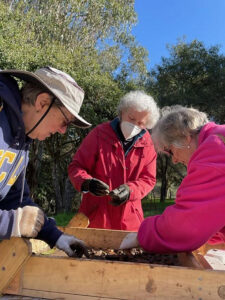By Edita McQuary
After a week of storms and floods, it was really wonderful to spend an afternoon in the sunshine at the Castro Adobe in Watsonville!
District Archeologist Mike Grone, ably assisted by District Historic Lead Interpreter Julie Sidel, Dustin (Dusty) McKenzie, archeology instructor at Cabrillo College, along with retired archeologist Rae Schwaderer, and Assistant Archeologist Julia Hartman, the team got to work.
The Castro Adobe is a 2-story hacienda built in 1848-49 by Jose Joaquin Castro shortly after the Mexican-American War and the signing of the Treaty of Guadalupe Hidalgo. Once completed, the Castro Adobe became the social center of the central California coast and many people came to visit and enjoy its social life. The second floor has a room called a fandango, where guests would have danced the night away.
The land on which the Castro Adobe stands is the homeland of the Awaswas-speaking Aptos people.
Seventeen volunteers of all ages, along with the professional people, sorted through 102 buckets of unscreened soils (commonly known as “mud” to us volunteers) left over from a construction project at the Adobe seven years ago.
The group was a nice mix of Dusty’s archeology students and retired educators and others interested in archeology.
This process is technically called “wet screening” and it certainly lived up to its name. Dumped into a screened box, the mud was sprayed with a hose to dissolve as much of it away as possible. Whatever soil was left was poured into the sorters’ screens so that they could search for any artifacts which might be displayed at the Adobe at some future date.
We found quite a few skeletons of rodents, some buttons not of the period, lots of nails, and the usual bits of broken crockery at the Castro Adobe. One of the most interesting items was a metal thimble. Small discs of repurposed plates have been noted in prior excavations. Two more were revealed on this day. Gaming pieces, perhaps?
This project was also lead by Jennifer Matlock, project coordinator of the Friends of Santa Cruz County Parks, who took a group of us down to the Adobe to show us the adobe interior and the room from which “our” dirt originally came. We also toured the cocina or kitchen..
The Friends of Santa Cruz County Parks kindly provided us with lunch, which we were able to enjoy in the sunshine on the Edna Kimbro House patio.
If you have not visited this interesting historical site, please look up their website for dates and times of operation.
There is a public Open House on Saturday, February 11th. Go to https://parks.ca.gov/?page_id=22271.
•••
If you are interested in volunteering for future archeological projects, contact Julie Sidel via email: Julia.Sidel@parks.ca.gov.
